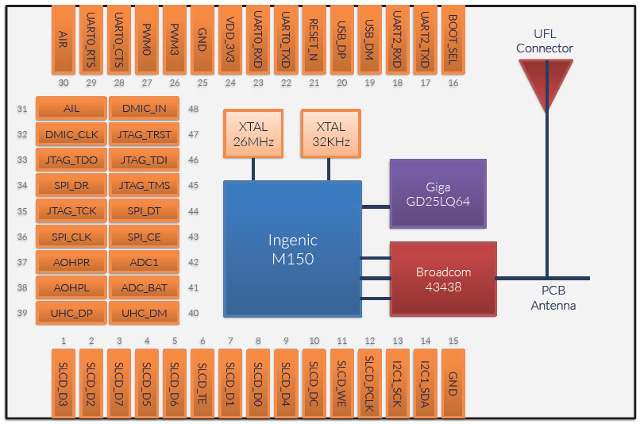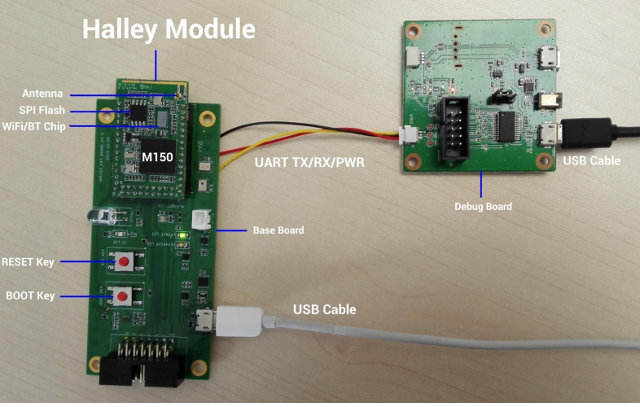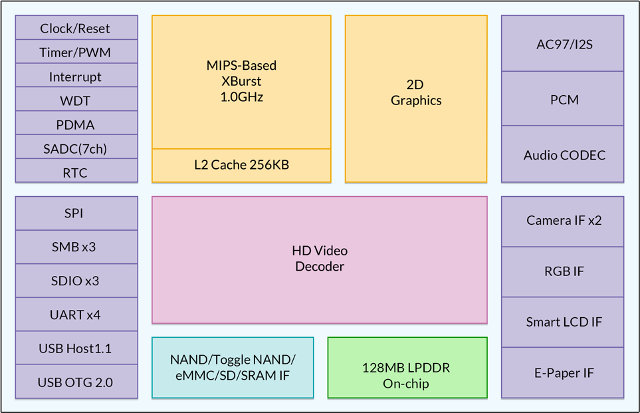Ingenic introduced Newton2 platform for wearables a few months ago, and the kit with an AMOLED display, camera board and other accessories should go on sale in March for $80. In the meantime, the company has also been working on a lower cost internet of things (IoT) module and development kit powered by Ingenic M150 with Wi-Fi and Bluetooth 4.1 targeting smart appliances, Wi-Fi speakers, smart toys, industrial control applications, and other smart devices.

Halley IoT module specifications:
- SoC – Ingenic M150 XBurst (MIPS) single-core processor up to 1.0GHz with 128MB LPDDR on-chip, 2D graphics GPU, VPU supporintg 720p30 H.264 video decoding.
- Storage – 8MP SPI NOR flash (GIGA GD25LQ64)
- Connectivity – Wi-Fi 802.11 b/g/n and Bluetooth 4.1 via Broadcom 43438 chip.
- Expansion headers (2mm pitch)
- 8-bit parallel LCD interface,
- Audio – MIC, Line-In and headphone, 2x I2S,
- SD card (MMC interface)
- USB device 2.0, and USB host 1.1
- 3x UART (2 with hardware flow control), 2x I2C, 1x SPI up to 50Mbps,
- 5-pin JTAG
- 2x 12-bit ADC,
- 2x PWM
- Power Supply – 3.3V
- Power Consumption – 2mW (Standby, no radio); 10 mW (Standby, Wi-Fi)
- Dimensions – 24 x 40 x 2.4 mm

The module is running Linux 3.10 with TCP/IP stack, and the company claims Android OS could also run on external storage. This would have to be a lightweight version of Android as only 128MB RAM is available. The development kit is comprised of the module, a baseboard, and a debug board.

The baseboard includes power circuitry to power the board with a micro USB port, reset and boot keys, some LEDs, a 14-pin male header, and UART connection to the debug board. It would have been good to have a micro SD slot on the back of the board, but none seems to have been included.
Even the board has not been formally launched, some documentation is already available for download including a product brief, a datasheet, and a developer’s guide. A Linux demo image and the SDK have also been released. The SDK includes a toolchain, source code for Linux and U-boot, drivers & tools, and a demo Android app (Airkiss).

It’s the first time I see details about Ingenic M150, so it might interesting to go through the specs:
- CPU – XBurst core, 1.0GHz (MIPS-based). 32KB L1 cache, 256KB L2 cache.
- GPU – X2D: Resizing, Rotating, Mirror, Color Convention and OSD etc.
- VPU – Video encoder: H.264, D1@30fps. Video decoder: H.264, MPEG-1/2/4, VC-1, VP8, RV9, 720P@30fps.
- Memory
- On-chip 128MB LPDDR, up to 320Mbps.
- 64-bit ECC NAND flash, 512B/2KB/4KB/8KB/16KB page size.
- Conventional and toggle NAND flash.
- Display
- LCD controller with OSD: TFT, SLCD, up to 1280*720@60Hz(BPP24).
- Embedded E-Ink controller with color engine.
- Camera – DVP interface, up to 2048 x 2048.
- Audio – Embedded audio CODEC; Digital DMIC controller; AC97/I2S/SPDIF interface for external audio codec; PCM interface, master and slave mode.
- ADC – 7 channels SAR A/D controller, 12-bit resolution.
- On-chip Peripherals
- USB 2.0 OTG, USB 1.1 Host.
- MMC/SD/SDIO controller.
- Full-duplex UART port.
- Synchronous serial interface.
- Two-wire SMB serial interface.
- Security – Total 256bits OTP memory.
- Package – BGA261, 11 x 11 x 1.4 (mm), 0.5mm pitch.
That confirms it’s one of the rare SoC with enough built-in RAM to run Linux. Renesas RZ/A1 is another one, but with only 10MB RAM, and a Cortex A9 core.
Halley IoT module and development kit will be available around March 10, for respectively $20 and $50. You can find more information, and ordering information on Ingenic’s Halley module page.
Thanks to Victor for the tip.

Jean-Luc started CNX Software in 2010 as a part-time endeavor, before quitting his job as a software engineering manager, and starting to write daily news, and reviews full time later in 2011.
Support CNX Software! Donate via cryptocurrencies, become a Patron on Patreon, or purchase goods on Amazon or Aliexpress





Seems strange to have an 8MB SPI Flash device on board these days instead of a microSD slot for a Linux-scale device.
@Brian
With prices below $1 those SPI flash chips are good for low cost devices. While SD card is much more flexible, it requires a socket and a card (so several bucks more). eMMC is quite bigger and expensive too. Also spring contacts of the card socket is something to be avoided in rugged designs.
I tried to download the SDK on the http://www.ingenic.com/en/?newton/id/7.html page without success (Baidu chinese). Is it available somewhere else? Any mirrors?
@gicho
Try Jdownloader, or that method: http://www.cnx-software.com/2015/01/14/downloading-files-on-baidu-or-via-http-bittorrent-or-metalink-in-linux-with-baiduexporter-aria2-and-yaaw/
It might work better.
@gicho
fast mirror for Ingenic FTP for Halley
ftp://grids.be/mirror/ftp.ingenic.cn/DevSupport/Platform/Halley/